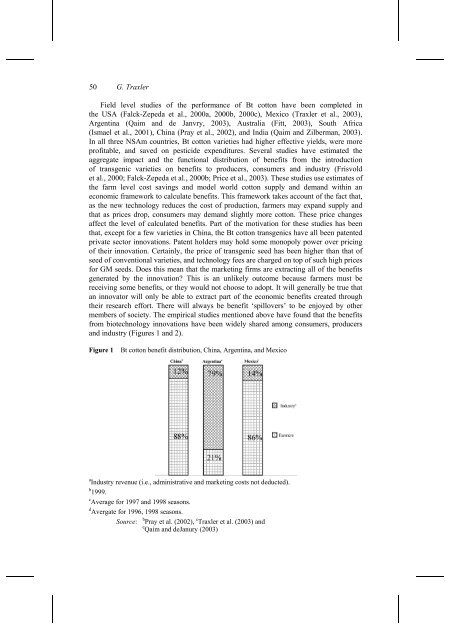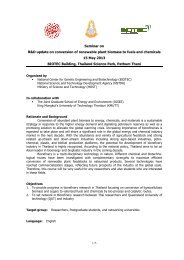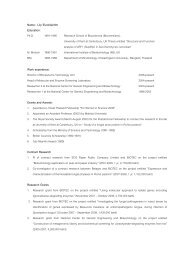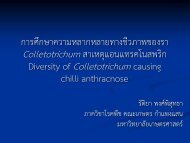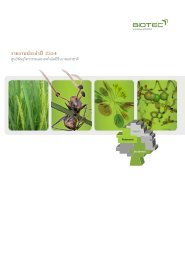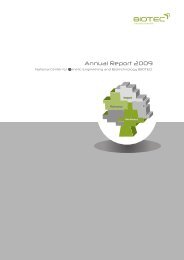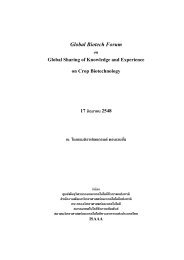The GMO experience in North and South America Greg Traxler
The GMO experience in North and South America Greg Traxler
The GMO experience in North and South America Greg Traxler
Create successful ePaper yourself
Turn your PDF publications into a flip-book with our unique Google optimized e-Paper software.
50 G. <strong>Traxler</strong>Field level studies of the performance of Bt cotton have been completed <strong>in</strong>the USA (Falck-Zepeda et al., 2000a, 2000b, 2000c), Mexico (<strong>Traxler</strong> et al., 2003),Argent<strong>in</strong>a (Qaim <strong>and</strong> de Janvry, 2003), Australia (Fitt, 2003), <strong>South</strong> Africa(Ismael et al., 2001), Ch<strong>in</strong>a (Pray et al., 2002), <strong>and</strong> India (Qaim <strong>and</strong> Zilberman, 2003).In all three NSAm countries, Bt cotton varieties had higher effective yields, were moreprofitable, <strong>and</strong> saved on pesticide expenditures. Several studies have estimated theaggregate impact <strong>and</strong> the functional distribution of benefits from the <strong>in</strong>troductionof transgenic varieties on benefits to producers, consumers <strong>and</strong> <strong>in</strong>dustry (Frisvoldet al., 2000; Falck-Zepeda et al., 2000b; Price et al., 2003). <strong>The</strong>se studies use estimates ofthe farm level cost sav<strong>in</strong>gs <strong>and</strong> model world cotton supply <strong>and</strong> dem<strong>and</strong> with<strong>in</strong> aneconomic framework to calculate benefits. This framework takes account of the fact that,as the new technology reduces the cost of production, farmers may exp<strong>and</strong> supply <strong>and</strong>that as prices drop, consumers may dem<strong>and</strong> slightly more cotton. <strong>The</strong>se price changesaffect the level of calculated benefits. Part of the motivation for these studies has beenthat, except for a few varieties <strong>in</strong> Ch<strong>in</strong>a, the Bt cotton transgenics have all been patentedprivate sector <strong>in</strong>novations. Patent holders may hold some monopoly power over pric<strong>in</strong>gof their <strong>in</strong>novation. Certa<strong>in</strong>ly, the price of transgenic seed has been higher than that ofseed of conventional varieties, <strong>and</strong> technology fees are charged on top of such high pricesfor GM seeds. Does this mean that the market<strong>in</strong>g firms are extract<strong>in</strong>g all of the benefitsgenerated by the <strong>in</strong>novation? This is an unlikely outcome because farmers must bereceiv<strong>in</strong>g some benefits, or they would not choose to adopt. It will generally be true thatan <strong>in</strong>novator will only be able to extract part of the economic benefits created throughtheir research effort. <strong>The</strong>re will always be benefit ‘spillovers’ to be enjoyed by othermembers of society. <strong>The</strong> empirical studies mentioned above have found that the benefitsfrom biotechnology <strong>in</strong>novations have been widely shared among consumers, producers<strong>and</strong> <strong>in</strong>dustry (Figures 1 <strong>and</strong> 2).Figure 1Bt cotton benefit distribution, Ch<strong>in</strong>a, Argent<strong>in</strong>a, <strong>and</strong> Mexicoa Industry revenue (i.e., adm<strong>in</strong>istrative <strong>and</strong> market<strong>in</strong>g costs not deducted).b 1999.c Average for 1997 <strong>and</strong> 1998 seasons.d Avergate for 1996, 1998 seasons.Source:b Pray et al. (2002), c <strong>Traxler</strong> et al. (2003) <strong>and</strong>e Qaim <strong>and</strong> deJanury (2003)


